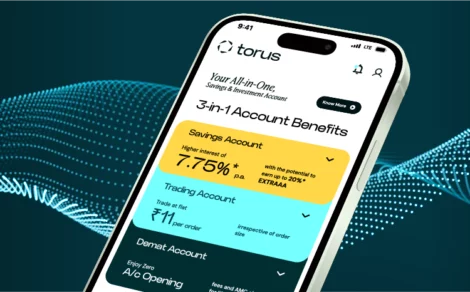Dematerialisation is the process of converting physical share certificates into digital form. This makes buying, selling, transferring, and holding shares easier, safer, and more cost-effective. Instead of keeping paper documents, all securities are stored electronically in a demat account. The goal of dematerialisation is to simplify trading and reduce risks like loss, theft, or damage of physical certificates. It also lowers transaction costs and eliminates paperwork.
Continue reading this blog to gain detailed insights about what is dematerialisation, its features, benefits and more.
Dematerialisation Meaning
Dematerialisation is the process by which physical financial assets like paper share certificates are converted into electronic form. This makes trading and investing easier, more rapid, and safer. Instead of dealing with paper documents, the investors hold their securities in a digital account known as a demat account.
There lies minimal chance of security going missing or getting stolen and damaged. This also reduces paperwork and allows for quicker dealings. These accounts are managed by banks and financial institutions with the intention of safe and smooth trading. Dematerialisation has gained wide popularity in stock markets to enhance efficiency and transparency as regards investments by individuals and businesses alike.
In India, the Securities and Exchange Board of India (SEBI) oversees two main depositories: Central Depository Services (India) Limited (CDSL) and National Securities Depository Limited (NSDL). These depositories manage and store electronic securities securely. Depository participants (DP) are intermediaries that connect investors to either depository, allowing people to buy and sell securities.
What are the Benefits of Dematerialisation?
The benefits of dematerialisation are the following:
-
Safety
To dematerialise securities is to accept a transfer in bookkeeping for stock market transactions electronically. This averts the fear of possible robbery, damage, and loss of having shares in physical forms.
-
Minimal Paperwork
Dematerialisation helps facilitate paperless transactions while trading. With securities being easily tradable electronically after dematerialisation, all transactions can occur without any paperwork. This also results in lower administration expenses for listed companies.
-
Loan Facility
You can avail a loan against your dematerialised holdings. Securities in the demat account are usually accepted for taking such loans.
-
Monitoring Investments
Dematerialisation allows you to pool all your investments in one account initially for ease of control and online access at any point in time. Therefore, you can periodically keep track of your portfolio and rebalance it whenever necessary.
-
Easy Receiving Corporate Benefits
Dematerialisation permits corporates to quickly credit benefits, such as dividends, interest, and refunds, to investors’ demat accounts with minimal administrative costs. Moreover, changes due to stock splits, bonus shares, rights shares, etc., are also automatically sent to demat accounts.
Process of Dematerialisation
The dematerialisation process starts with the opening of a demat account. Here is a detailed step-by-step guide to follow to dematerialise securities with a new demat account:
- Choose a Depository Participant: The majority of the financial institutions and brokerage service firms are categorised as depository participants (DP).
- Fill Out the Account Opening Form: First, you must fill out an account opening form of the DP. This can be done both online and offline.
- Submit the Relevant Documents: Submit relevant copies of identity proof, income proof, address proof, bank account statements and photographs for verification. It is mandatory to attest all necessary copies of documents.
- Sign the Agreement: A standardised agreement consists of a detailed overview of all regulations, the charges incurred, and applicable terms and conditions.
- Document Verification: A respective staff member will connect with you after verifying your submitted documents and completing the KYC (know your customer) procedure.
- Generating Demat Number and Client ID: Once all the documents are successfully verified, your client ID and demat account number are generated. Make sure to use these details to access your demat account online.
The RTA is an intermediary between investors and a depository (CDSL or NSDL). Its main role remains in finalising the crediting and transfer of shares. The NSDL allocates an International Securities Identification Number (ISIN) to each share of the company once it has entered the depository system.
Importance of Dematerialisation of Shares
Management of paper-based documents, especially for finance and investments, can be quite difficult. When such paperwork increases, the chances of losing important documents or damaging these documents also increase. The loss of crucial documents such as share certificates can thereby result in delays, monetary losses, and even total losses for the investors.
Here are the points noted discussing the importance of the dematerialisation of shares:
-
No Loss of Documents:
Investors no longer have to worry about losing physical share certificates due to the existence of electronic records.
-
Saving on Stamp Duty:
In the case where shares are transferred electronically, stamp duty is saved at a 0.5% charge.
-
No Duplicate Certificates:
Getting duplicates of paper certificates if they are lost becomes time-consuming and expensive, and dematerialisation removes the problem.
-
Bonuses and Dividends Credited Directly:
Investors are credited with bonuses and dividends directly into their accounts with no risk of loss.
-
Lower Interest on Loans:
Loans against shares in a demat account have lower interest rates compared to those applicable for shares in paper form.
In simple words, dematerialisation has made stock trading safer, smoother and more cost-effective. It has enhanced security, minimised paperwork and made investments less risky. This system is beneficial for both businesses and individuals, making the financial market more efficient.
What are the Challenges in the Dematerialisation Process?
Here are the challenges faced in the process of dematerialisation:
- High-frequency Share Trading: The market is now more liquid but more volatile as a result of easily executed orders and effective communication. Hence, short-term earners are preferred over long-term return investors.
- Technology Challenges: Individuals with poor literacy or computer skills are at a great disadvantage compared to those with superior computer skills and better software.
- Dematerialisation of Shares of a Firm: It is possible for any private limited company to issue dematerialised securities by entering into a contract with depositories such as NSDL and an existing Registrar and Transfer Agent.
Final Words
To conclude, dematerialisation has now put the Indian stock exchanges on a new platform. It made trading financial securities easier, safer, and more efficient. An investor no longer needs to handle paper share certificates, and thus, the chances of loss, theft, or damage have been reduced significantly.
With dematerialisation, there is no need to visit offices to collect documents. Everything is electronically managed. Bonus, dividends, and loans against shares are directly credited to the investor’s account.
Why wait any longer? Explore demat account benefits and open demat account with Torus Digital to hold your securities digitally and start trading on the stock market in India.








